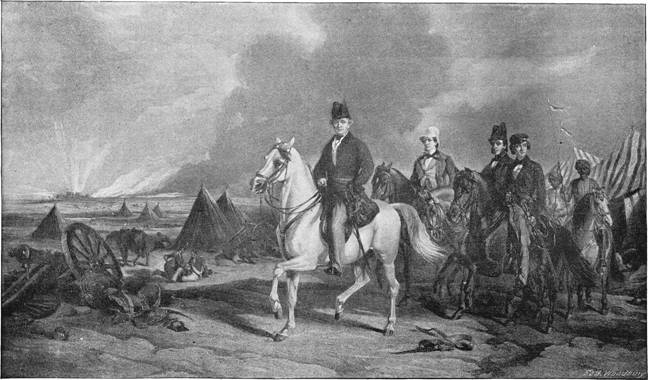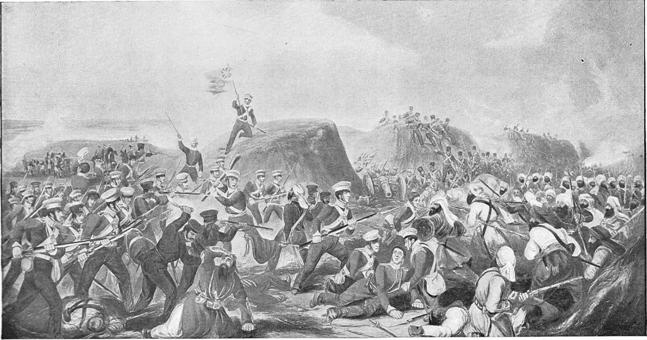|
The
existence of British territory in India, side by
side with territory under British protection and
States wholly under native rule, was a condition of
things neither conducive to peace nor likely to be
of a permanent nature. A single spark dropped among
the warlike races inhabiting that vast peninsula was
often enough to cause wide-spreading conflagration;
and, however agreeable it might be to British
consciences, it would be unphilosophic in the
highest degree to attribute the blame for such
outbreaks exclusively to the native rulers and
people. Trouble broke out early in 1843 which led to
the annexation by the British of Scinde, a fine
territory lying between the Indian Ocean and the
Cutch on the south, and southern Afghanistan and the
Punjab on the north. Scinde had been divided into
three provinces—Hyderabad, Khyrpore, and Meerpore—each
ruled by a group of Ameers or hereditary chiefs,
descended from Beloochee conquerors, who, it was
said, most cruelly oppressed the people under them.
Successive treaties had been effected with these
rulers by the Indian Government, but the disaster
which fell on the British arms in Cabul seems to
have encouraged them to withhold some of the tribute
due by them under the latest treaty, and they began
warlike preparations. In 1842 Lord Ellenborough
appointed Sir Charles Napier Commander-in-Chief of
the British troops in Scinde, with instructions to
inflict signal punishment on any chiefs detected in
treachery, at the same time empowering him to make a
fresh treaty, relieving the Ameers from the payment
of any subsidy for the support of British troops
This treaty was at length signed, though it must be
confessed that the Ameers were only induced to
consent to it by the threatening display of Napier's
force. On February 15, 1843, the British Residency
at Hyderabad was attacked by 8,000 troops with six
guns, led by one or more of the Ameers, and the
garrison of 100 men under Major Outram was driven
out after a gallant resistance.
Napier
marched to Muttaree the following day with a force
of 3,000, attacked the Ameers, who had an army of
22,000 Beloochees, on the morning of the 17th at
Meeanee, six miles from Hyderabad, defeated them,
and captured their whole artillery, ammunition,
baggage, and considerable treasure. The British loss
amounted to 256 killed and wounded. Hyderabad was
occupied, but the Ameer of Meerpore was still under
arms, holding a strong position at Dubba, about four
miles from Hyderabad, with 20,000 men. Napier
attacked him, and a battle lasting for three hours
ended in the complete defeat of Shere Mahomed and
the occupation of Meerpore by the British. Sir
Charles Napier continued warlike operations at
intervals against the hill tribes north of
Shikarpore, and there can be but one opinion of the
masterly way in which he handled the troops under
his command. But the policy of the Governor-General
was open to some difference of opinion. He had
carried things with a high hand in dealing with the
Ameers, and early in 1844 he was recalled by the
unanimous vote of the Court of Directors of the East
India Company, and Sir Henry Hardinge was appointed
in his place.

SIR HENRY, AFTERWARDS VISCOUNT, HARDINGE AND HIS
STAFF AT FEROZESHAH
Hardinge
applied himself to the peaceful preparation of
railroad schemes for the development of India, but
at the close of 1845 events again forced the
Government forward on the path of fresh conquest. At
that time the Punjab, a kingdom consisting both of
independent Sikh States and those under British
protection, was under nominal rule of the boy-king,
Dhuleep Singh, and his mother, the Ranee; but his
government at Lahore was distracted by faction and
lay at the mercy of his own powerful army. In
December 1845, the Sikh forces, for some reason
which has never been clearly explained, began
massing on the British frontier, and crossed the
Sutlej, 15,000 or 20,000 strong, on the 13th. Sir
Hugh Gough advanced by forced marches to meet them,
attacked them at Moodkee and defeated them,
capturing seventeen guns. The Sikhs retired to a
strongly-entrenched camp at Ferozeshah, whither
Gough, reinforced by Sir John Littler's division
from Ferozepore, followed them on the 21st. The Sikh
army was now upwards of. 50,000 strong, with 108
heavy guns in fixed batteries. The British force
consisted of 16,70o men and sixty-nine guns, chiefly
horse artillery. There ensued one of the severest
conflicts in the history of our Indian Empire.
Beginning on the 21st it lasted through part of the
22nd, and ended in the gallant Sikhs being driven
across the Sutlej with the loss of many killed and
wounded, and no less than seventy guns. The
Governor-General, Sir Henry Hardinge, acted as a
volunteer, second in command to Sir Hugh Gough, in
this memorable action.
Early in
January 1846, Sirdar Runjoor Singh, again advancing
towards the 'frontier, took up a strong position on
the British side of the Sutlej, threatening Gough's
line of communications with Loodiana. Major-General
Sir Harry Smith attacked him at Aliwal on January
28, and, notwithstanding the great superiority in
numbers of the enemy, obtained a brilliant victory
over the Sikhs, capturing their camp and fifty-two
guns. But more fighting had to be done before the
army of the Punjab could be finally subdued. The
Sikhs still lay at Sobraon with 30,000 of their best
troops, defended by a triple line of breast works,
flanked by redoubts, and armed with seventy guns.
Here Sir Hugh Gough attacked them on the morning of
February 10, the Governor-General again being
present as second in command. At nine o'clock, after
an hour's cannonade, Brigadier Stacey advanced to
storm the entrenchments with four battalions, which
behaved with splendid gallantry under a very heavy
and well-directed fire. They stormed the position,
and, being well supported, forced their way into the
fortress. By eleven o'clock all was over. The Sikhs
were in full flight across the Sutlej, leaving
behind them piles of dead and wounded, sixty - seven
guns, 200 camel swivels, and all their baggage and
ammunition. The British loss consisted of 320
killed, including seventeen officers (among whom
were Major-General Sir Robert Dick, General McLaren,
and Brigadier Taylor), and 2,063 wounded, including
139 officers. But the carnage among the Sikhs was
far more terrible. It is supposed that not less than
eight or ten thousand of them perished in action or
were drowned in crossing the river under the fire of
the British artillery. On February 22 Gough occupied
the citadel of Lahore ; the Governor-General issued
a proclamation from that place, and a treaty was
subsequently concluded establishing Dhuleep Singh as
Maharajah, tributary to the British Government.

THE BATTLE OF SOBRAON, February
so, 0846.
This
illustration is reproduced from a popular, but
somewhat quaint, coloured print representing the 3rd
Regiment, with Major-General Sir Henry Smith's
division, in action at Sobraon. It forms an
instructive contrast with the military prints of the
present day.
Site Copyright Worldwide 2010. Text and
poetry written by
Sir Hubert Maxwell is not to be reproduced without
express Permission.
|